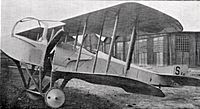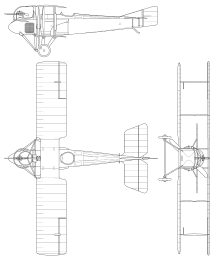SPAD A types
The SPAD A 1 to SPAD A 5 - also known as SPAD SA 1 - SA-5 and SA 1 - SA 5 or SPAD S-a1 - S-a5 - were biplanes - aircraft of the French manufacturer Société Pour L'Aviation et ses Dérivés , the first development of this company after the takeover by the aircraft pioneer Louis Blériot in 1914.
Basics
These machines were unusual designs. At the time, there were no synchronized machine guns that could fire through the propeller circle without damaging it. Many other aircraft manufacturers solved this problem with pusher propellers , which pushed the aircraft and were therefore attached to the rear of the machine. The Swiss manufacturer Dufaux and the British Royal Aircraft Factory with the RAFFE10 and the SPAD A.1 took a different approach: They integrated the propeller into the fuselage. In the Spad A.1 the propeller was mounted almost immediately before the pilot before the screw a Bugschützen- or observer status was appropriate, the shooter / observer therefore had the propeller of a Gnôme et Rhône - rotary engine was driven in the back behind, only separated by a metal grille. SPAD had this arrangement patented.
Flight tests showed, however, that the crews were not satisfied with this propeller arrangement, since both crew members were sitting relatively close to the propeller and the risk of serious injuries was correspondingly high. An understanding between the two was also not possible, rollover during landing was usually fatal for the observer. In addition, the entire observer gondola was sometimes lost after being damaged in combat.
construction
The fuselage and wings were fabric-covered wooden structures. The nose gunner or observer stand, designed as a nacelle, could be folded to the side via the propeller for maintenance of the engine and to start the engine.
The upper and lower wings were of the same length and were not staggered; the upper wings had ailerons. Vertical center struts were added to stabilize the wings to prevent the wings from fluttering; this also patented construction became a typical distinctive feature of the later SPAD constructions. In the observer's cockpit, a movable Lewis MG was mounted on a tubular steel bracket. To protect the observer from the rotating propeller, a wire mesh guard was attached behind the observer seat.
All versions had a 2-wheel chassis on a continuous axle and a tail spur.
SPAD A 1
The A1 became the first fighter aircraft developed by Louis Béchereau , SPAD's chief engineer. Different sources are available for the A1. According to the first variant, this type was not built in series, only a prototype is said to have left the SPAD factory. The successful first flight took place on May 21, 1915, after which 11 machines were ordered by the French air force .
SPAD A 2
The A 2 began flight tests as an improved version of the A 1 on May 21, 1915, and only a few months later the first machines went to the front squadrons. The flight characteristics, however, remained unsatisfactory.
There are different sources for this successor to the SPAD A1. Most sources name 99 units built, 42 of which are said to have remained in France, the remaining 57 are said to have been received by the Russian air forces; some of these were equipped with ski runners in winter . Another source names 40 machines built, 30 of which are said to have remained in France.
The main purpose of this machine, which was equipped with an 82 hp Le Rhône rotary engine, Type 9J, was a reconnaissance aircraft and ground support aircraft. While the French machines were quickly withdrawn from service, the Russian Air Force , although unpopular with Russian airmen, continued to use them due to their chronic shortage of emergency aircraft. On November 25, 1916, the Russian pilot Karpov and his observer Bratolyubovim shot down a German aircraft near Wulka.
Individual machines were even still in use during the Russian civil war . The young Polish Air Force took over four A-2s from Austrian booty stocks .
SPAD A 3
Another prototype was the SPAD A 3, a school version of the A 2. In this machine, the trainee pilot was supposed to take the place of the nose gunner; the aircraft had double controls.
SPAD A 4
Since the 80 hp engine used so far proved to be too weak, a more powerful engine was to improve the performance of the series version developed from the A3, called the SPAD A4. The first prototype flew on February 22, 1916. From this version, whose first flight took place on February 22, 1916, 11–12 machines (other sources: 10 or 56 machines) are said to have been delivered to Russia, of which after the First World War there were six left.
SPAD A 5
The last version - probably just a prototype - was the SPAD A 5, equipped with a Renault 8 engine.
Technical specifications
| Parameter | Data SPAD A 1 | Data SPAD A 2 | Data SPAD A 4 |
|---|---|---|---|
| crew | 2 | ||
| length | 7.30 m | 7.85 m | |
| span | 9.10 m | 9.55 m | |
| height | 2.60 m | 2.65 m | 2.50 m |
| Wing area | 25.35 m² | 24.56 m² | 25.30 m² |
| Empty mass | 435 kg | 565 kg | |
| Takeoff mass | 710 kg | Max. 735 kg | 960 kg |
| Wing loading | 38.00 kp / m² | ||
| Power load | 7.90 kg / hp | ||
| drive | a Le-Rhône 9C radial engine with 80 HP (59 kW) | a Le-Rhone 9J radial engine with 80 HP (59 kW) | an air-cooled Le-Rhone 9C radial engine with 110 HP (81 kW) |
| Top speed | 135 km / h at sea level | 154 km / h at sea level | 135 km / h near the ground |
| Rise time | at 2000 m: 12:30 min | at 1000 m: 6 min at 2000 m: 12:18 min at 3000 m: 34 min |
|
| practical summit height | 4,300 m | 3,500 m | |
| Range | 300 km | 250 km | |
| Flight duration | 2 h | ||
| Armament | a movable Lewis machine gun , cal. 7.7 mm in the nose gunner's position | a movable MG 7.62 mm (Etienne) in the nose gunner's position | |
| Bomb load | - | 23 kg bombs (2 × 11.5 kg) | |
literature
- Enzo Angelucci, Paolo Matricardi: Airplanes from the beginnings to the First World War. Wiesbaden 1976, ISBN 3-8068-0391-9
- Gérard Bordes: Encyclopédie de l'Aviation. Vol. 8, Editions Atlas 1981.
- John F. Connors: SPAD Fighters in action. Squadron / Signal Books 1989, ISBN 0-89747-217-9 .
- Kenneth Munson: Fighter Planes 1914-19. Zurich 1968.
- Heinz Nowarra: The Development of Airplanes 1914-18. Munich 1959.
- Ray Rimell (Ed.): SPAD's alarming A.4. from: Windsock International No1 / Vol. 5, Berkhamsted, spring 1989, p. 22ff.
Web links
- http://www.wwiaviation.com/french1915.html
- http://www.pilotfriend.com/photo_albums/timeline/SPAD%20A2.htm
Individual evidence
- ↑ Patent No. 498,338 of February 27, 1915, expanded on June 7, 1915 with No. 22,088
- ↑ Patent No. 488.191 of June 4, 1915
- ↑ a b cf. Rimell, Ray (Ed.): SPAD's alarming A.4 , from: Windsock International No1 / Vol. 5, Berkhamsted, Spring 1989, p. 24
- ↑ http://www.aviafrance.com/aviafrance1.php?ID=2433&ID_CONSTRUCTEUR=1231&ANNEE=0&ID_MISSION=0&MOTCLEF=
- ↑ cf. u. a. Rimell, Ray (Ed.): SPAD's alarming A.4 , from: Windsock International No1 / Vol. 5, Berkhamsted, Spring 1989, p. 24

